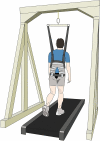Modulation of spatial and temporal modules in lower limb muscle activations during walking with simulated reduced gravity
- PMID: 34285306
- PMCID: PMC8292403
- DOI: 10.1038/s41598-021-94201-9
Modulation of spatial and temporal modules in lower limb muscle activations during walking with simulated reduced gravity
Abstract
Gravity plays a crucial role in shaping patterned locomotor output to maintain dynamic stability during locomotion. The present study aimed to clarify the gravity-dependent regulation of modules that organize multiple muscle activities during walking in humans. Participants walked on a treadmill at seven speeds (1-6 km h-1 and a subject- and gravity-specific speed determined by the Froude number (Fr) corresponding to 0.25) while their body weight was partially supported by a lift to simulate walking with five levels of gravity conditions from 0.07 to 1 g. Modules, i.e., muscle-weighting vectors (spatial modules) and phase-dependent activation coefficients (temporal modules), were extracted from 12 lower-limb electromyographic (EMG) activities in each gravity (Fr ~ 0.25) using nonnegative matrix factorization. Additionally, a tensor decomposition model was fit to the EMG data to quantify variables depending on the gravity conditions and walking speed with prescribed spatial and temporal modules. The results demonstrated that muscle activity could be explained by four modules from 1 to 0.16 g and three modules at 0.07 g, and the modules were shared for both spatial and temporal components among the gravity conditions. The task-dependent variables of the modules acting on the supporting phase linearly decreased with decreasing gravity, whereas that of the module contributing to activation prior to foot contact showed nonlinear U-shaped modulation. Moreover, the profiles of the gravity-dependent modulation changed as a function of walking speed. In conclusion, reduced gravity walking was achieved by regulating the contribution of prescribed spatial and temporal coordination in muscle activities.
© 2021. The Author(s).
Conflict of interest statement
The authors declare no competing interests.
Figures









Similar articles
-
Human myoelectric spatial patterns differ among lower limb muscles and locomotion speeds.Physiol Rep. 2020 Dec;8(23):e14652. doi: 10.14814/phy2.14652. Physiol Rep. 2020. PMID: 33278064 Free PMC article.
-
Similarity of muscle synergies extracted from the lower limb including the deep muscles between level and uphill treadmill walking.Gait Posture. 2018 Jan;59:134-139. doi: 10.1016/j.gaitpost.2017.10.007. Epub 2017 Oct 8. Gait Posture. 2018. PMID: 29031138
-
Shared and task-specific muscle synergies of Nordic walking and conventional walking.Scand J Med Sci Sports. 2018 Mar;28(3):905-918. doi: 10.1111/sms.12992. Epub 2017 Nov 3. Scand J Med Sci Sports. 2018. PMID: 29027265
-
Human locomotion under reduced gravity conditions: biomechanical and neurophysiological considerations.Biomed Res Int. 2014;2014:547242. doi: 10.1155/2014/547242. Epub 2014 Aug 28. Biomed Res Int. 2014. PMID: 25247179 Free PMC article. Review.
-
Contributions to the understanding of gait control.Dan Med J. 2014 Apr;61(4):B4823. Dan Med J. 2014. PMID: 24814597 Review.
Cited by
-
Muscle synergies inherent in simulated hypogravity running reveal flexible but not unconstrained locomotor control.Sci Rep. 2024 Feb 1;14(1):2707. doi: 10.1038/s41598-023-50076-6. Sci Rep. 2024. PMID: 38302569 Free PMC article.
-
Lower-limb muscle synergies in musician's dystonia: a case study of a drummer.Front Neurol. 2024 Nov 18;15:1489143. doi: 10.3389/fneur.2024.1489143. eCollection 2024. Front Neurol. 2024. PMID: 39624668 Free PMC article.
-
Sensorimotor adaptation of locomotor synergies to gravitational constraint.NPJ Microgravity. 2024 Jan 11;10(1):5. doi: 10.1038/s41526-024-00350-2. NPJ Microgravity. 2024. PMID: 38212311 Free PMC article.
-
The kinectome: A comprehensive kinematic map of human motion in health and disease.Ann N Y Acad Sci. 2022 Oct;1516(1):247-261. doi: 10.1111/nyas.14860. Epub 2022 Jul 15. Ann N Y Acad Sci. 2022. PMID: 35838306 Free PMC article.
-
Spatiotemporal patterns of throwing muscle synergies in yips-affected baseball players.Sci Rep. 2024 Feb 1;14(1):2649. doi: 10.1038/s41598-024-52332-9. Sci Rep. 2024. PMID: 38302478 Free PMC article.
References
-
- Ritzmann, R., Gollhofer, A. & Freyler, K. In Sensory Motor and Behavioral Research in Space (eds Hilbig, R. et al.) 1–36 (Springer International Publishing, 2017).
Publication types
MeSH terms
LinkOut - more resources
Full Text Sources

